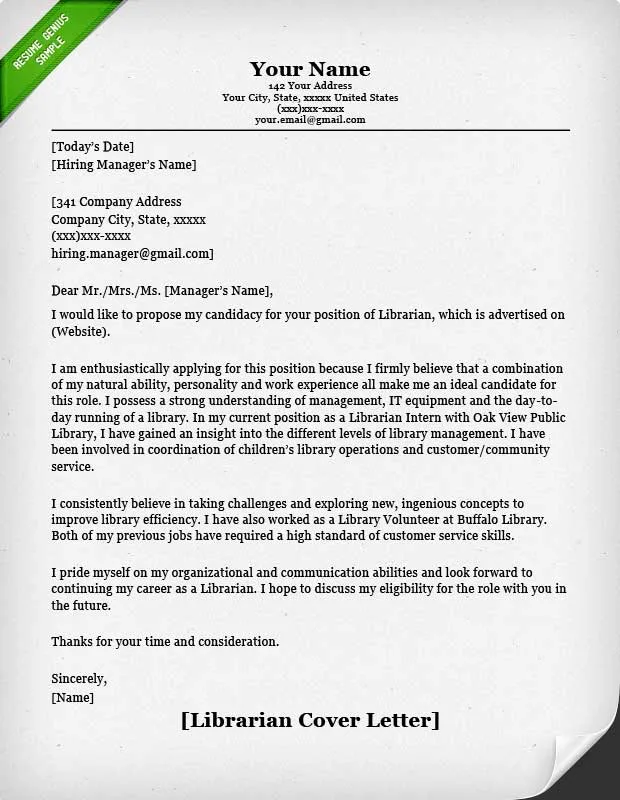What is a Librarian Cover Letter
A librarian cover letter is a crucial document that accompanies your resume when applying for librarian positions. It serves as an introduction, providing an opportunity to showcase your qualifications, skills, and enthusiasm for the role. Unlike a resume, which presents a factual overview of your experience, a cover letter allows you to elaborate on your achievements, explain your career goals, and demonstrate your suitability for the specific job. A well-crafted cover letter can significantly increase your chances of getting an interview, making it a vital tool in your job search arsenal. It’s a chance to connect with the hiring manager on a more personal level and set yourself apart from other applicants.
Why Is a Great Cover Letter Important
In the competitive field of librarianship, a great cover letter is exceptionally important. It’s often the first impression you make on a potential employer. A strong cover letter can highlight your unique skills and experiences that might not be immediately apparent from your resume. It gives you a platform to articulate why you’re the perfect fit for the position and the organization. Furthermore, it shows your attention to detail and your ability to communicate effectively, both essential skills for librarians. A well-written cover letter demonstrates your professionalism, your passion for the field, and your understanding of the library’s mission and values. Without a compelling cover letter, your application may be overlooked, even if you have excellent qualifications.
Key Elements of a Librarian Cover Letter
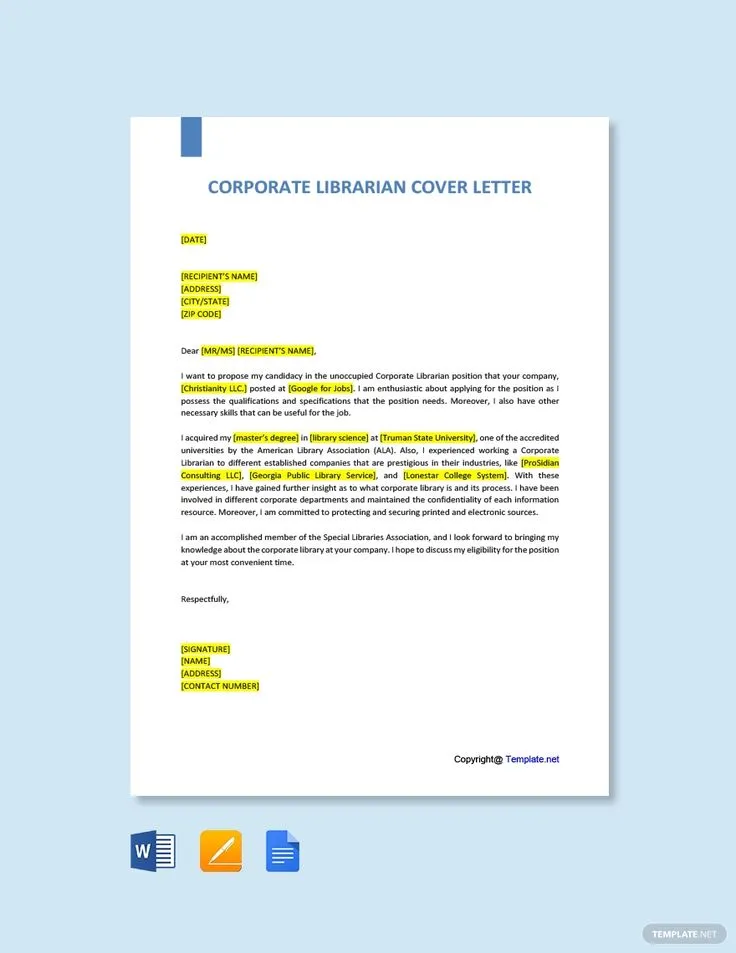
Contact Information
At the top of your cover letter, include your contact information. This should include your full name, address, phone number, and email address. Ensure your email address is professional and easy to read. If you’re applying for a specific position, it’s also a good idea to include the date and the name and address of the hiring manager or the library. This level of detail shows that you’ve taken the time to research the organization and personalize your application. Make sure all information is up-to-date and accurate to avoid any communication issues. This simple step demonstrates your professionalism and attention to detail, qualities highly valued in a librarian.
Greeting
Address the hiring manager by name if possible. Research the library’s website or use LinkedIn to find out the name of the hiring manager or the person responsible for reviewing applications. If you can’t find a specific name, use a general salutation like “Dear Hiring Committee.” Avoid generic greetings such as “To Whom It May Concern.” A personalized greeting immediately shows that you’ve taken the initiative to learn about the organization and the specific job. This small gesture can significantly impact the overall tone of your cover letter and help you make a positive first impression, setting you apart from other applicants who might use a generic greeting. (Image file name: professional-greeting.webp)
Body Paragraphs

The body paragraphs are where you sell yourself. This section is the core of your cover letter, where you showcase your skills, experience, and passion for the role. Each paragraph should focus on a specific aspect of your qualifications and how they align with the job requirements. Use clear and concise language, and avoid jargon that the hiring manager might not understand. Provide concrete examples to illustrate your achievements and skills. Explain why you are interested in this particular position, and demonstrate your enthusiasm for the library and its mission. Tailor each paragraph to the specific job requirements, and be sure to proofread your letter carefully for any errors. This is your chance to really shine and make a strong case for why you are the best candidate for the job.
Highlighting Relevant Skills and Experience
When highlighting your skills and experience, focus on those most relevant to the job description. Review the job posting carefully and identify the key requirements. Then, provide specific examples of how you’ve demonstrated those skills in previous roles or during your education. Quantify your achievements whenever possible. For example, instead of saying “Managed a library collection,” you could say “Managed a library collection of over 50,000 items, ensuring accurate cataloging and efficient retrieval.” This level of detail shows the hiring manager that you have the skills and experience necessary to excel in the role. Tailor your examples to match the specific requirements outlined in the job description to make your application as relevant as possible. (Image file name: librarian-skills-experience.webp)
Demonstrating Passion for Libraries and Information
Showcase your genuine passion for libraries and information science. Explain what excites you about the field and why you are drawn to the library’s mission. Discuss any volunteer work, personal projects, or professional development activities that demonstrate your commitment. Briefly share what aspects of the job specifically appeal to you, and how you see yourself contributing to the library’s success. Expressing your passion for the field helps you connect with the hiring manager on a personal level and shows that you are not just looking for a job, but a career. Use language that conveys enthusiasm and commitment, and make it clear that you are enthusiastic about supporting the library’s users and promoting literacy and lifelong learning. (Image file name: library-passion.webp)
Tailoring the Letter to the Specific Job
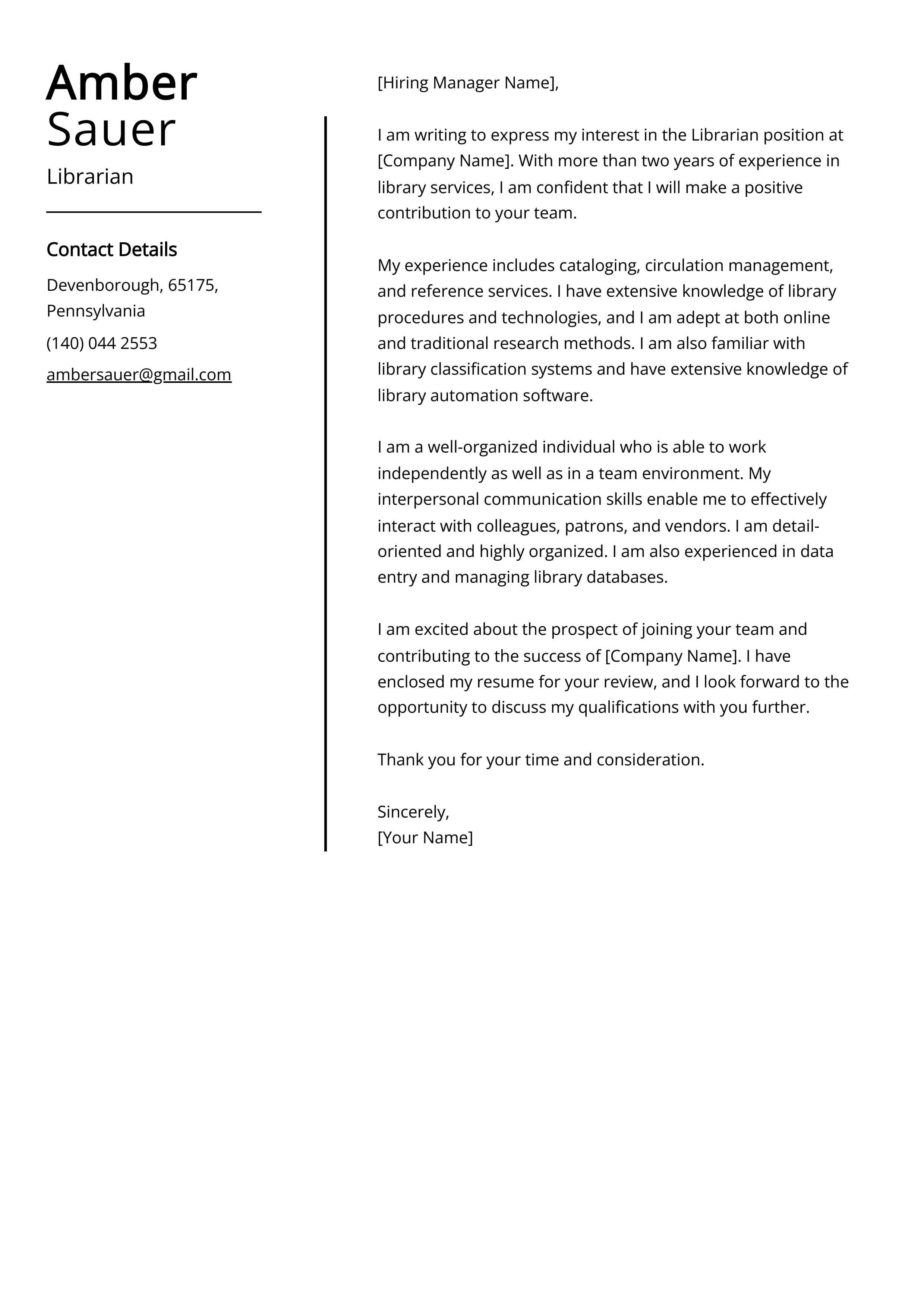
Customize each cover letter for the specific job you are applying for. Do not send a generic cover letter. Carefully read the job description and identify the key requirements, and tailor your letter to address those requirements directly. Use the same keywords and phrases from the job description in your letter, but avoid keyword stuffing. Research the library and the specific department to understand its mission, values, and current projects. This will allow you to demonstrate your understanding of the organization and how your skills and experience align with its needs. Show that you’ve taken the time to learn about the library and express your genuine interest in the specific position. This shows initiative and increases your chances of being called for an interview.
Closing and Call to Action
In the closing paragraph, express your enthusiasm for the position and reiterate your interest in an interview. Thank the hiring manager for their time and consideration. Provide your contact information again, including your phone number and email address, in case they need to contact you. End with a professional closing, such as “Sincerely” or “Best regards,” followed by your name. A clear call to action encourages the hiring manager to move forward with your application. By providing all necessary contact information again, you make it easy for the hiring manager to reach you and demonstrate your eagerness to continue in the hiring process. This final touch leaves a lasting positive impression and enhances your prospects of getting an interview.
Formatting and Style Tips for a Librarian Cover Letter
Font and Layout Considerations
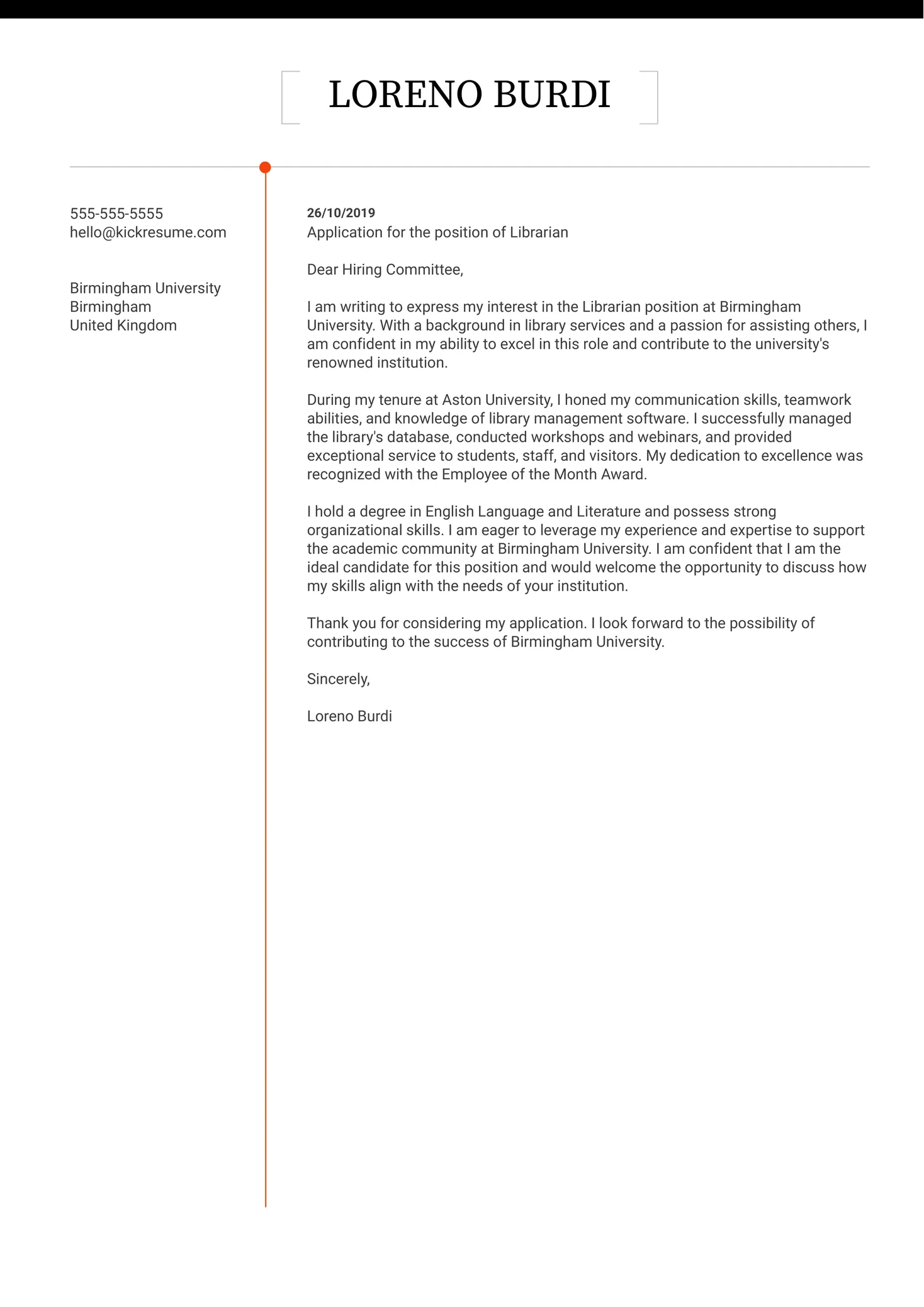
Choose a professional font, such as Times New Roman, Arial, or Calibri, in a size between 10 and 12 points. Use a standard layout with 1-inch margins on all sides. Ensure that your letter is easy to read, with clear spacing between paragraphs. Use bolding or italics sparingly to highlight key information. Use a simple and clean design that is visually appealing and professional. The layout should guide the reader’s eye through the letter, highlighting important information. Ensure your contact information, salutation, and closing are properly aligned for a polished and organized appearance. A well-formatted cover letter demonstrates your attention to detail and commitment to professionalism. (Image file name: cover-letter-formatting.webp)
Proofreading and Editing
Proofread your cover letter carefully for any grammatical errors, spelling mistakes, or typos. Read the letter aloud to catch any awkward phrasing or sentence structures. Ask a friend, family member, or career counselor to review your cover letter for clarity, accuracy, and style. Ensure that your cover letter is free of errors and easy to understand. This is a crucial step that shows you have taken the time to ensure that your work is of high quality. Poor grammar and spelling errors can detract from your application and make a negative impression on the hiring manager. Thorough proofreading ensures that your cover letter reflects your attention to detail and your ability to communicate effectively. (Image file name: proofreading-editing.webp)
Dos and Don’ts of Writing a Librarian Cover Letter
Dos
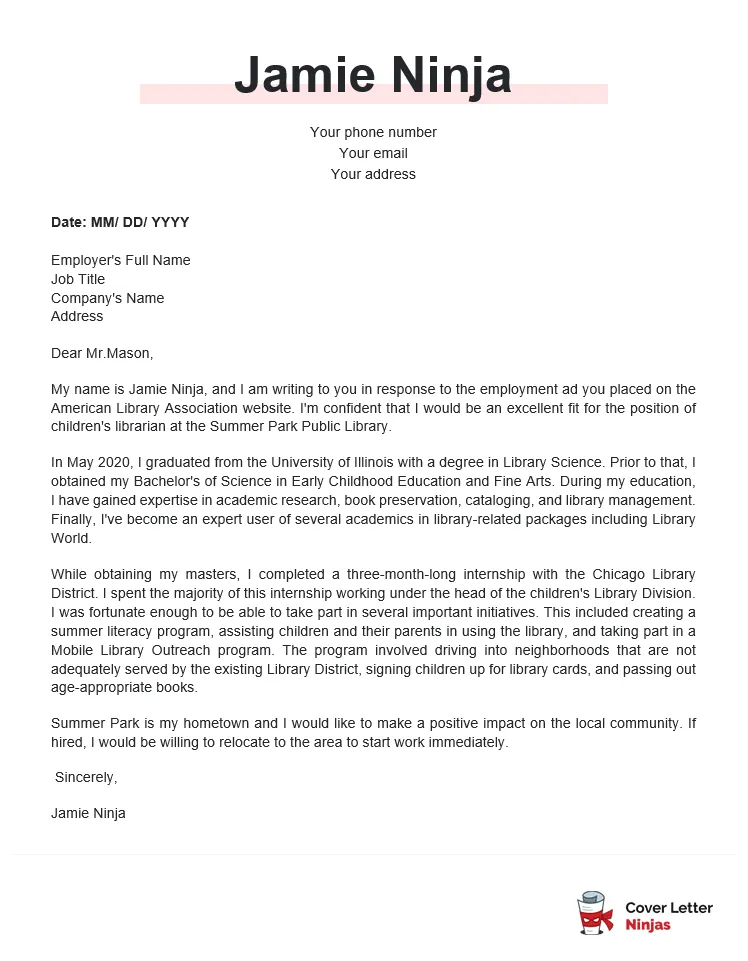
- Tailor the cover letter to each specific job
- Highlight relevant skills and experience
- Showcase your passion for libraries and information
- Use a professional tone and format
- Proofread carefully for errors
- Research the library and the specific position
Don’ts
- Send a generic cover letter
- Include irrelevant information
- Use jargon or clichés
- Focus solely on your needs or wants
- Make grammatical errors or typos
- Exceed one page in length
- Use unprofessional email address
